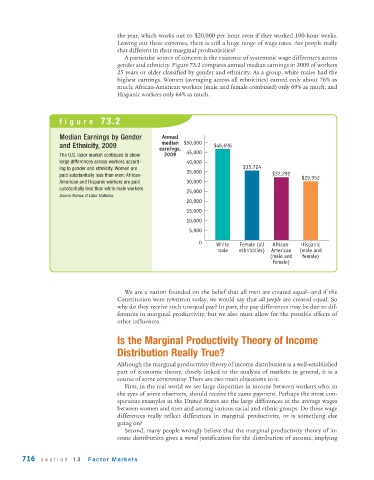Page 758 - Krugmans Economics for AP Text Book_Neat
P. 758
the year, which works out to $20,000 per hour even if they worked 100-hour weeks.
Leaving out these extremes, there is still a huge range of wage rates. Are people really
that different in their marginal productivities?
A particular source of concern is the existence of systematic wage differences across
gender and ethnicity. Figure 73.2 compares annual median earnings in 2009 of workers
25 years or older classified by gender and ethnicity. As a group, white males had the
highest earnings. Women (averaging across all ethnicities) earned only about 76% as
much; African-American workers (male and female combined) only 69% as much; and
Hispanic workers only 64% as much.
figure 73.2
Median Earnings by Gender Annual
and Ethnicity, 2009 median $50,000 $46,696
earnings, 45,000
The U.S. labor market continues to show 2009
large differences across workers accord- 40,000
ing to gender and ethnicity. Women are 35,000 $35,724
paid substantially less than men; African- $32,292 $29,952
American and Hispanic workers are paid 30,000
substantially less than white male workers. 25,000
Source: Bureau of Labor Statistics.
20,000
15,000
10,000
5,000
0 White Female (all African- Hispanic
male ethnicities) American (male and
(male and female)
female)
We are a nation founded on the belief that all men are created equal—and if the
Constitution were rewritten today, we would say that all people are created equal. So
why do they receive such unequal pay? In part, the pay differences may be due to dif-
ferences in marginal productivity, but we also must allow for the possible effects of
other influences.
Is the Marginal Productivity Theory of Income
Distribution Really True?
Although the marginal productivity theory of income distribution is a well-established
part of economic theory, closely linked to the analysis of markets in general, it is a
source of some controversy. There are two main objections to it.
First, in the real world we see large disparities in income between workers who, in
the eyes of some observers, should receive the same payment. Perhaps the most con-
spicuous examples in the United States are the large differences in the average wages
between women and men and among various racial and ethnic groups. Do these wage
differences really reflect differences in marginal productivity, or is something else
going on?
Second, many people wrongly believe that the marginal productivity theory of in-
come distribution gives a moral justification for the distribution of income, implying
716 section 13 Factor Markets

